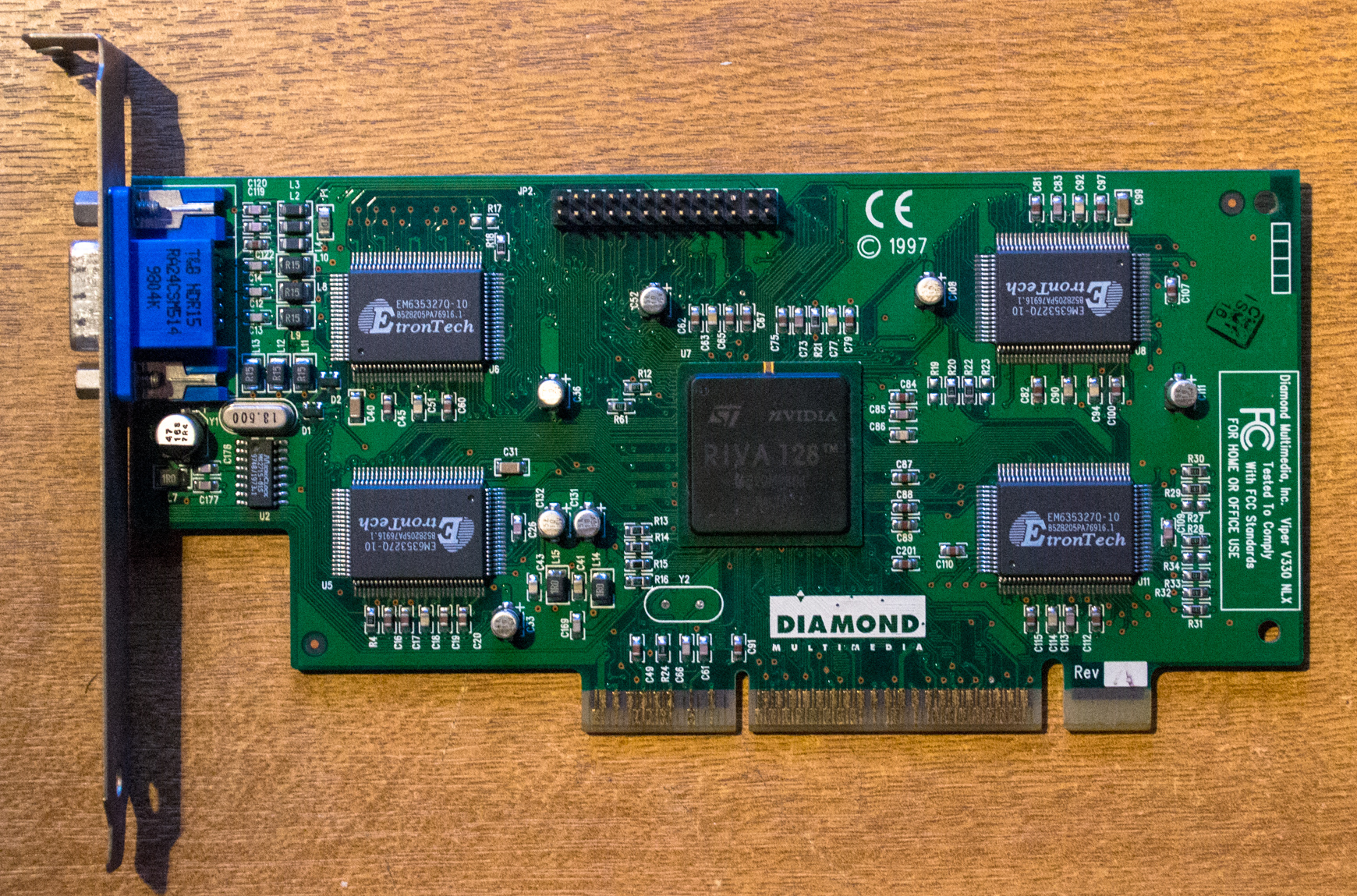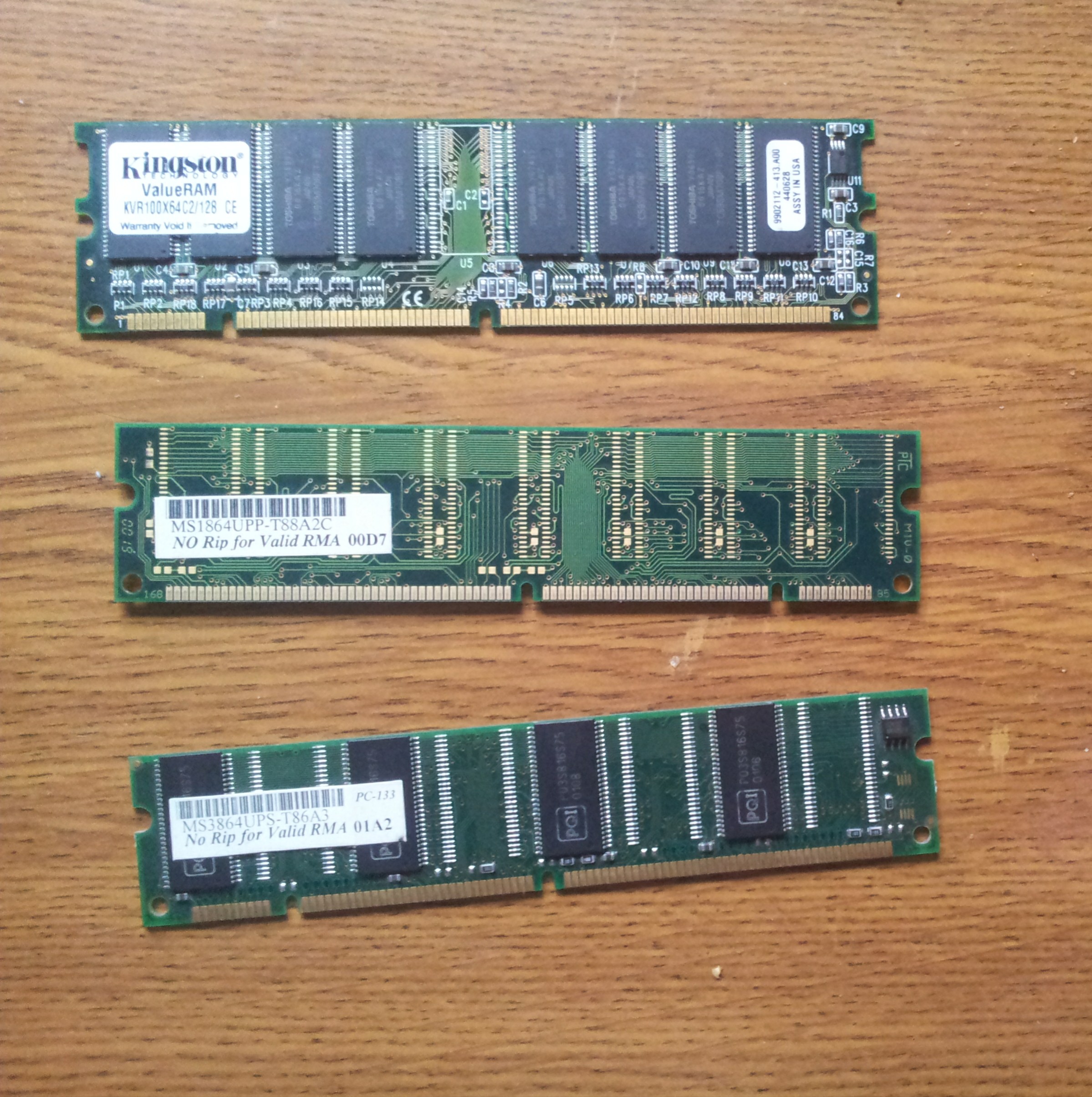|
RIVA 128
Released in August 1997 by Nvidia, the RIVA 128, or "NV3", was one of the first consumer graphics processing units to integrate 3D acceleration in addition to traditional 2D and video acceleration. Its name is an acronym for ''Real-time Interactive Video and Animation accelerator''.RIVA 128 Brochure Nvidia, accessed October 9, 2007. Following the less successful "" accelerator, the RIVA 128 was the first product to gain Nvidia widespread recognition. It was also a major change in technological direction for Nvidia. [...More Info...] [...Related Items...] OR: [Wikipedia] [Google] [Baidu] |
Z-buffering
A depth buffer, also known as a z-buffer, is a type of data buffer used in computer graphics to represent depth information of objects in 3D space from a particular perspective. Depth buffers are an aid to rendering a scene to ensure that the correct polygons properly occlude other polygons. Z-buffering was first described in 1974 by Wolfgang Straßer in his PhD thesis on fast algorithms for rendering occluded objects. A similar solution to determining overlapping polygons is the painter's algorithm, which is capable of handling non-opaque scene elements, though at the cost of efficiency and incorrect results. In a 3D-rendering pipeline, when an object is projected on the screen, the depth (z-value) of a generated fragment in the projected screen image is compared to the value already stored in the buffer (depth test), and replaces it if the new value is closer. It works in tandem with the rasterizer, which computes the colored values. The fragment output by the rasterizer ... [...More Info...] [...Related Items...] OR: [Wikipedia] [Google] [Baidu] |
Accelerated Graphics Port
Accelerated Graphics Port (AGP) is a parallel expansion card standard, designed for attaching a video card to a computer system to assist in the acceleration of 3D computer graphics. It was originally designed as a successor to PCI-type connections for video cards. Since 2004, AGP was progressively phased out in favor of PCI Express (PCIe), which is serial, as opposed to parallel; by mid-2008, PCI Express cards dominated the market and only a few AGP models were available, with GPU manufacturers and add-in board partners eventually dropping support for the interface in favor of PCI Express. Advantages over PCI AGP is a superset of the PCI standard, designed to overcome PCI's limitations in serving the requirements of the era's high-performance graphics cards. The primary advantage of AGP is that it doesn't share the PCI bus, providing a dedicated, point-to-point pathway between the expansion slot(s) and the motherboard chipset. The direct connection also allows for higher clo ... [...More Info...] [...Related Items...] OR: [Wikipedia] [Google] [Baidu] |
Voodoo2
The Voodoo2 (or Voodoo2) is a set of three specialized 3D graphics chips on a single chipset setup, made by 3dfx. It was released in February 1998 as a replacement for the original Voodoo Graphics chipset. The card runs at a chipset clock rate of 90 MHz and uses 100 MHz EDO DRAM, and is available for the PCI interface. The Voodoo2 comes in two models, one with 8 MB RAM and one with 12 MB RAM. The 8 MB card has 2 MB of memory per texture mapping unit (TMU) vs. 4 MB on the 12 MB model. The 4 MB framebuffer on both cards support a maximum screen resolution of 800 × 600, while the increased texture memory on the 12 MB card allows more detailed textures. Some boards with 8 MB can be upgraded to 12 MB with an additional daughter board. Each of the three chips present on the card has its own 64-bit RAM interface, giving the card a "total" bus width of 192 bits or 800MB/s per chip. The Voodoo2 has an increased chip-count compared to the original two-chip Voodoo car ... [...More Info...] [...Related Items...] OR: [Wikipedia] [Google] [Baidu] |
Framebuffer
A framebuffer (frame buffer, or sometimes framestore) is a portion of random-access memory (RAM) containing a bitmap that drives a video display. It is a memory buffer containing data representing all the pixels in a complete video frame. Modern video cards contain framebuffer circuitry in their cores. This circuitry converts an in-memory bitmap into a video signal that can be displayed on a computer monitor. In computing, a screen buffer is a part of computer memory used by a computer application for the representation of the content to be shown on the computer display. The screen buffer may also be called the video buffer, the regeneration buffer, or regen buffer for short. Screen buffers should be distinguished from video memory. To this end, the term off-screen buffer is also used. The information in the buffer typically consists of color values for every pixel to be shown on the display. Color values are commonly stored in 1-bit binary (monochrome), 4-bit palettized, 8-bit ... [...More Info...] [...Related Items...] OR: [Wikipedia] [Google] [Baidu] |
Shared Memory Architecture
In computer science, shared memory is memory that may be simultaneously accessed by multiple programs with an intent to provide communication among them or avoid redundant copies. Shared memory is an efficient means of passing data between programs. Depending on context, programs may run on a single processor or on multiple separate processors. Using memory for communication inside a single program, e.g. among its multiple threads, is also referred to as shared memory. In hardware In computer hardware, ''shared memory'' refers to a (typically large) block of random access memory (RAM) that can be accessed by several different central processing units (CPUs) in a multiprocessor computer system. Shared memory systems may use: * uniform memory access (UMA): all the processors share the physical memory uniformly; * non-uniform memory access (NUMA): memory access time depends on the memory location relative to a processor; * cache-only memory architecture (COMA): the local memor ... [...More Info...] [...Related Items...] OR: [Wikipedia] [Google] [Baidu] |
Gigabyte
The gigabyte () is a multiple of the unit byte for digital information. The prefix ''giga'' means 109 in the International System of Units (SI). Therefore, one gigabyte is one billion bytes. The unit symbol for the gigabyte is GB. This definition is used in all contexts of science (especially data science), engineering, business, and many areas of computing, including storage capacities of hard drives, solid state drives, and tapes, as well as data transmission speeds. However, the term is also used in some fields of computer science and information technology to denote (10243 or 230) bytes, particularly for sizes of RAM. Thus, prior to 1998, some usage of ''gigabyte'' has been ambiguous. To resolve this difficulty, IEC 80000-13 clarifies that a ''gigabyte'' (GB) is 109 bytes and specifies the term ''gibibyte'' (GiB) to denote 230 bytes. These differences are still readily seen for example, when a 400 GB drive's capacity is displayed by Microsoft Windows as 372 G ... [...More Info...] [...Related Items...] OR: [Wikipedia] [Google] [Baidu] |
Bus (computing)
In computer architecture, a bus (shortened form of the Latin '' omnibus'', and historically also called data highway or databus) is a communication system that transfers data between components inside a computer, or between computers. This expression covers all related hardware components (wire, optical fiber, etc.) and software, including communication protocols. Early computer buses were parallel electrical wires with multiple hardware connections, but the term is now used for any physical arrangement that provides the same logical function as a parallel electrical busbar. Modern computer buses can use both parallel and bit serial connections, and can be wired in either a multidrop (electrical parallel) or daisy chain topology, or connected by switched hubs, as in the case of Universal Serial Bus (USB). Background and nomenclature Computer systems generally consist of three main parts: * The central processing unit (CPU) that processes data, * The memory that holds the p ... [...More Info...] [...Related Items...] OR: [Wikipedia] [Google] [Baidu] |
Synchronous Dynamic Random-access Memory
Synchronous dynamic random-access memory (synchronous dynamic RAM or SDRAM) is any DRAM where the operation of its external pin interface is coordinated by an externally supplied clock signal. DRAM integrated circuits (ICs) produced from the early 1970s to early 1990s used an ''asynchronous'' interface, in which input control signals have a direct effect on internal functions only delayed by the trip across its semiconductor pathways. SDRAM has a ''synchronous'' interface, whereby changes on control inputs are recognised after a rising edge of its clock input. In SDRAM families standardized by JEDEC, the clock signal controls the stepping of an internal finite-state machine that responds to incoming commands. These commands can be pipelined to improve performance, with previously started operations completing while new commands are received. The memory is divided into several equally sized but independent sections called ''banks'', allowing the device to operate on a memory a ... [...More Info...] [...Related Items...] OR: [Wikipedia] [Google] [Baidu] |
Mebibyte
The byte is a unit of digital information that most commonly consists of eight bits. Historically, the byte was the number of bits used to encode a single character of text in a computer and for this reason it is the smallest addressable unit of memory in many computer architectures. To disambiguate arbitrarily sized bytes from the common 8-bit definition, network protocol documents such as The Internet Protocol () refer to an 8-bit byte as an octet. Those bits in an octet are usually counted with numbering from 0 to 7 or 7 to 0 depending on the bit endianness. The first bit is number 0, making the eighth bit number 7. The size of the byte has historically been hardware-dependent and no definitive standards existed that mandated the size. Sizes from 1 to 48 bits have been used. The six-bit character code was an often-used implementation in early encoding systems, and computers using six-bit and nine-bit bytes were common in the 1960s. These systems often had memory words ... [...More Info...] [...Related Items...] OR: [Wikipedia] [Google] [Baidu] |
RAMDAC
A random-access memory digital-to-analog converter (RAMDAC) is a combination of three fast digital-to-analog converters (DACs) with a small static random-access memory (SRAM) used in computer graphics display controllers or video cards to store the color palette and to generate the analog signals (usually a voltage amplitude) to drive a color monitor. The logical color number from the display memory is fed into the address inputs of the SRAM to select a palette entry to appear on the data output of the SRAM. This entry is composed of three separate values corresponding to the three components (red, green, and blue) of the desired physical color. Each component value is fed to a separate DAC, whose analog output goes to the monitor, and ultimately to one of its three electron guns (or equivalent in non- CRT displays). RAMDACs became obsolete as DVI, HDMI, DisplayPort and other digital interface technology became mainstream, which transfer video data digitally (via transition-minim ... [...More Info...] [...Related Items...] OR: [Wikipedia] [Google] [Baidu] |
MPEG-2
MPEG-2 (a.k.a. H.222/H.262 as was defined by the ITU) is a standard for "the generic video coding format, coding of moving pictures and associated audio information". It describes a combination of Lossy compression, lossy video compression and Lossy compression, lossy audio data compression methods, which permit storage and transmission of movies using currently available storage media and transmission bandwidth. While MPEG-2 is not as efficient as newer standards such as H.264/AVC and HEVC, H.265/HEVC, backwards compatibility with existing hardware and software means it is still widely used, for example in over-the-air digital television broadcasting and in the DVD-Video standard. Main characteristics MPEG-2 is widely used as the format of digital television signals that are broadcast by terrestrial television, terrestrial (over-the-air), Cable television, cable, and direct broadcast satellite Television, TV systems. It also specifies the format of movies and other programs th ... [...More Info...] [...Related Items...] OR: [Wikipedia] [Google] [Baidu] |






_BT458LPJ135.jpg)